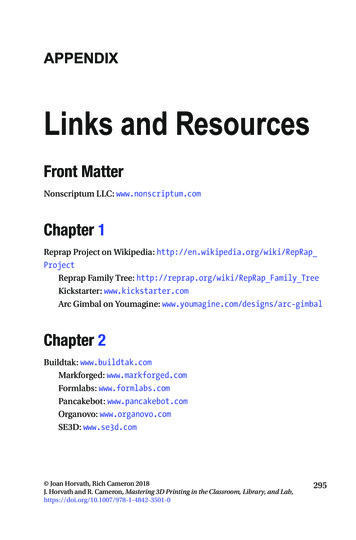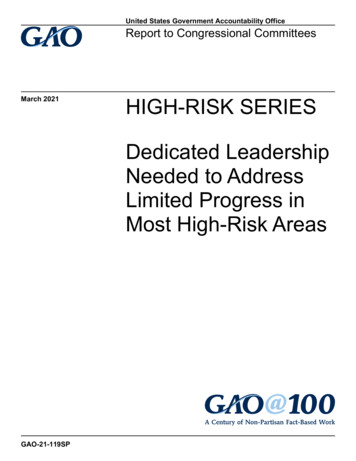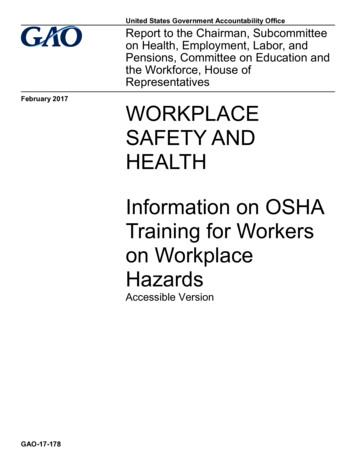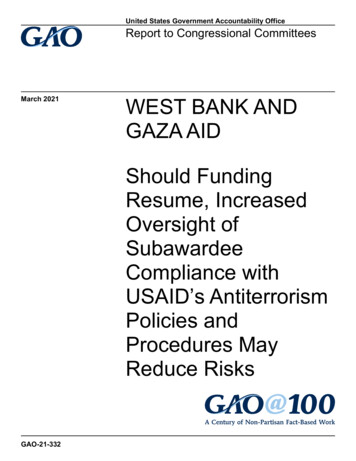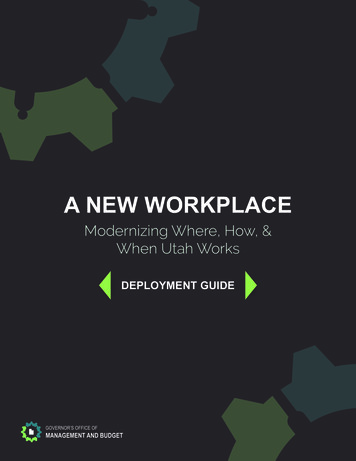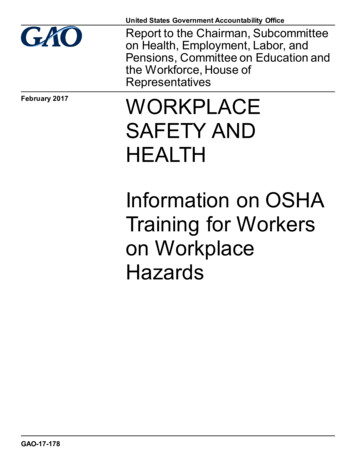
Transcription
United States Government Accountability OfficeReport to the Chairman, Subcommitteeon Health, Employment, Labor, andPensions, Committee on Education andthe Workforce, House ofRepresentativesFebruary 2017WORKPLACESAFETY ANDHEALTHInformation on OSHATraining for Workerson WorkplaceHazardsGAO-17-178
February 2017WORKPLACE SAFETY AND HEALTHInformation on OSHA Training for Workers onWorkplace HazardsHighlights of GAO-17-178, a report to theChairman, Subcommittee on Health,Employment, Labor, and Pensions, Committeeon Education and the Workforce, House ofRepresentativesWhy GAO Did This StudyWhat GAO FoundIn fiscal year 2016, approximately900,000 workers were trained throughOSHA’s Outreach Training Program,the agency’s primary mechanism fortraining workers on the basics ofoccupational safety and health. OSHAoffers this training through OSHAauthorized in-person and onlinetraining providers. GAO was asked toreview OSHA’s administration of theprogram.The Department of Labor’s Occupational Safety and Health Administration’s(OSHA) Outreach Training Program–which offers training on job hazardrecognition and avoidance–reflects many of the attributes of a well-designedtraining program identified in GAO’s training guide. OSHA is not required tofollow GAO’s training guide; however, the program’s design reflects at least oneindicator for six of the seven attributes of a well-designed training program GAOhas identified. For example, OSHA used an appropriate mix of centralized anddecentralized approaches by developing core learning objectives and contentrequirements for the courses but allowed training providers to modify thecurriculum to meet the specific needs of their audience. In addition, OSHAofficials told GAO that they took into account the leading causes of workerdeaths and the most common workplace safety and health violations todetermine topics to be covered in the training.GAO examined (1) the extent to whichthe program aligns with leadingpractices in designing an effectivetraining program, (2) the process fordocumenting successful completion ofthe training and whether internalcontrols are in place to assurecompletion is accurately documented,and (3) how OSHA oversees trainingproviders and assesses the results ofthe program. GAO compared OSHA’sdesign and evaluation efforts for itstraining program with leading practicesin GAO’s training guide (GAO-04546G) and federal internal controlstandards, and analyzed fiscal year2012-2016 OSHA data (the mostrecent available) on time frames forprocessing completion card requestsfrom online training providers. GAOalso interviewed all nine online trainingproviders and five in-person trainingproviders, selected for having a highnumber of participants in fiscal year2015, as well as OSHA officials.GAO is not making recommendationsin this report.View GAO-17-178. For more information,contact Allison Baw den at (202) 512-7215 orbaw dena@gao.gov.OSHA documents successful course completion differently depending onwhether training was delivered in-person or online, but it uses the same controlsto prevent fraudulent completion cards from being issued. OSHA officials and thetraining providers GAO interviewed reported using several checks to preventfraudulent completion cards from being issued, such as verifying coursecompletion through automated and manual processes and comparing thenumber of cards requested to the number of registered students. AlthoughOSHA does not require workers to complete Outreach Training, some workersmay need to show proof of completion to satisfy requirements by their states,municipalities, employers, or unions. To obtain completion cards, Outreachtrainers who deliver in-person training submit course information through a webbased system, while online training providers mail documentation to OSHA.OSHA processed 91 percent of the card requests from online training providerswithin 2 weeks, which is within the 30-day deadline OSHA has set for itself,according to GAO’s analysis of OSHA data. OSHA officials reported that theyplan to allow all training providers to request completion cards electronically, butthe agency has not established a timeline for implementing this new process.According to OSHA officials, the agency is taking steps to modify its process forselecting online training providers and plans to incorporate electronic requestsfor completion cards into the new process.OSHA oversees the performance of training providers by routinely collecting andassessing data and investigating complaints and has taken some steps toassess the results of the program. Specifically, OSHA collects data from thetraining providers to help ensure that the training meets the programrequirements and that the trainers are delivering the Outreach Training coursesas intended. OSHA also investigates complaints it receives about trainingproviders, including issues such as the trainer not spending enough time onrequired safety topics. To assess program results, OSHA tracks the number ofworkers who take the Outreach Training courses to measure the reach of theprogram. According to OSHA data, from fiscal year 2000 to fiscal year 2016, thenumber of workers trained more than quadrupled from 200,522 to 900,010.OSHA also receives test results and student evaluations of the courses fromsome of the Outreach Training providers.United States Government Accountability Office
ContentsLetter1BackgroundOSHA’s Outreach Training Program Reflects Attributes of a WellDesigned Training ProgramOutreach Training Providers Use Automated and ManualProcesses and Controls to Document Students’ SuccessfulCourse CompletionOSHA Oversees Training Providers by Collecting Data andInvestigating Complaints, and Has Taken Some Steps toAssess Program ResultsAgency CommentsAppendix IGAO Contact and Staff Acknowledgments3812162426TablesTable 1: Extent to Which the Design of OSHA’s Outreach TrainingProgram Reflects GAO Identified Attributes for a WellDesigned Training ProgramTable 2: Selected OSHA Requirements for the 10-hourConstruction Outreach Training CourseTable 3: 11 Performance Elements OSHA Uses to Assess theEducation Centers’ Performance, Fiscal Year 201591117FiguresFigure 1: Growth in OSHA’s Outreach Training Program - Numberof Workers Trained From Fiscal Year 2000 to 2016Figure 2: OSHA Outreach Training Participants by Course Type,Fiscal Year 2016Figure 3: Course Completion Card Processing for OSHA’s Inperson and Online Outreach TrainingFigure 4: Results of OSHA’s Monitoring of the Education Centersby Performance Element, Fiscal Year 2015Figure 5: OSHA Targets for Number of Workers Trained throughIts Outreach Training Program and Actual Number ofWorkers Trained, Fiscal Years 2011-2016Figure 6: OSHA’s Requirements for Assessing Outreach TrainingCompared to Kirkpatrick Levels of EvaluationPage i7813192223GAO-17-178 OHSA Training
AbbreviationsDOLEducation CentersIACETOSHAOSH ActDepartment of LaborOSHA Training Institute Education CentersInternational Association for Continuing Educationand TrainingOccupational Safety and Health AdministrationOccupational Safety and Health Act of 1970This is a work of the U.S. government and is not subject to copyright protection in theUnited States. The published product may be reproduced and distributed in its entiretywithout further permission from GAO. However, because this work may containcopyrighted images or other material, permission from the copyright holder may benecessary if you wish to reproduce this material separately.Page iiGAO-17-178 OHSA Training
Letter441 G St. N.W.Washington, DC 20548February 7, 2017The Honorable Tim WalbergChairmanSubcommittee on Health, Employment, Labor, and PensionsCommittee on Education and the WorkforceHouse of RepresentativesDear Mr. Chairman:In 2014, approximately 4,800 workers died on the job, and employersreported about 3 million nonfatal work-related injuries, according to datacollected by the Department of Labor (DOL). DOL’s Occupational Safetyand Health Administration (OSHA) is responsible for protecting the safetyand health of the nation’s workers under the Occupational Safety andHealth Act of 1970 (OSH Act). 1 Ensuring that workers are properly trainedin recognizing and avoiding workplace hazards is an importantcomponent in establishing and maintaining a safe and healthy workplace.In fiscal year 2016, approximately 900,000 workers were trained in jobhazard recognition and avoidance through OSHA’s Outreach TrainingProgram. 2 In-person Outreach Training is provided to workers byOutreach trainers, safety professionals who have taken train-the-trainercourses at OSHA Training Institute Education Centers (EducationCenters), which are a national network of nonprofit organizationsauthorized by OSHA to deliver various types of occupational safety andhealth training. Since 2001, OSHA has also allowed Outreach Trainingcourses to be delivered online through authorized vendors. Participationin the program has grown substantially over time and although mostworkers take the training in-person, workers are increasingly taking thecourses online. You asked us to review OSHA’s administration of theprogram, including the in-person and online training, and to determinehow OSHA assesses the results of the program.This report examines (1) the extent to which OSHA’s Outreach TrainingProgram aligns with leading practices in designing an effective training1Pub. L. No. 91-596, 84 Stat. 1590 (codified as amended at 29 U.S.C. §§ 553, 651-78).2OSHA’s Outreach Training Program is designed for workers, but according to OSHAofficials, individuals trained can include workers, employers, safety professionals,supervisors, and students in high school and college. In this report, we use the term“workers” to refer collectively to all of these groups.Page 1GAO-17-178 OHSA Training
program, (2) the process OSHA uses to document students’ successfulcompletion of the training and the extent to which internal controls are inplace to assure completion is accurately documented, and (3) how OSHAoversees training providers and assesses the results of the program.To address all of our objectives, we interviewed OSHA officials;representatives from all nine online training providers; andrepresentatives from five Education Centers, selected because they hadamong the highest number of Outreach Training participants of all 27Education Centers in fiscal year 2015. Together, the 5 Education Centersaccounted for 46 percent of workers trained in-person that year. 3 We alsoobserved three Outreach Training courses—two in-person and oneonline. Our observations from these training courses are intended to beillustrative, and are not generalizable. To determine the extent to whichthe design of the Outreach Training Program reflects leading practices,we compared the information obtained through interviews with OSHAofficials and agency documentation to practices identified in GAO’s guidefor assessing training and federal internal control standards. 4 WhileGAO’s guide for assessing training is intended to help federal agenciesreview training and development programs for their employees, theattributes of effective training programs identified in the guide are derivedfrom sources that are generally applicable to training and can be used toreview a particular agency program or activity. To examine the processfor documenting successful course completion, we reviewed (1) OSHA’spolicies and procedures for issuing course completion cards and (2) otherinformation obtained from OSHA, the online training providers, and thefive Education Centers. We also analyzed the latest OSHA data availableat the time of our review from fiscal years 2012 through 2016 on thetimeframes for processing requests from online training providers for3There are currently 27 Education Centers.4GAO, Human Capital: A Guide for Assessing Strategic Training and Development Effortsin the Federal Government, GAO-04-546G (Washington, D.C.: Mar. 1, 2004) and GAO,Standards for Internal Control in the Federal Government, GAO-14-704G, (Washington,D.C.: Sept. 10, 2014). GAO’s guide for assessing training summarizes attributes ofeffective training programs related to four components of the training process: (1)planning/front-end analysis, (2) design/development, (3) implementation, and (4)evaluation. GAO obtained the information in this guide through consultations withgovernment officials and experts in the private sector, academia, and nonprofitorganizations; examinations of laws and regulations related to training and development inthe federal government; and a review of the literature on training and development issues.Page 2GAO-17-178 OHSA Training
course completion cards. 5 We assessed the reliability of OSHA’s cardprocessing data by (1) performing electronic testing of required dataelements, (2) reviewing existing information about the data and thesystem that produced them, and (3) interviewing agency officialsknowledgeable about the data. Based on these reviews, we determinedthat the data were sufficiently reliable for our purposes. To determine howOSHA oversees Outreach Training providers and assesses the results ofthe program, we reviewed OSHA’s reporting requirements for trainingproviders, monitoring procedures, and agency monitoring reports. Wealso compared OSHA’s efforts to training evaluation practices in GAO’straining guide (GAO-04-546G) and federal internal control standards.We conducted this performance audit from February 2016 to February2017 in accordance with generally accepted government auditingstandards. Those standards require that we plan and perform the audit toobtain sufficient, appropriate evidence to provide a reasonable basis forour findings and conclusions based on our audit objectives. We believethat the evidence obtained provides a reasonable basis for our findingsand conclusions based on our audit objectives.BackgroundOSHA is the federal agency responsible for administering theOccupational Safety and Health Act of 1970, as amended (OSH Act),which was enacted to assure safe and healthful working conditions for thenation’s workers. 6 As authorized by the act, OSHA sets and enforcesoccupational safety and health standards, which are regulations that setforth specific safety and health requirements with which covered5We did not analyze data on how long it takes for the Education Centers to processcourse completion cards for workers who take the training in person because theEducation Centers use different information systems to process the cards and no singledata source exists that would allow us to analyze the data.6Pub. L. No. 91-596, 84 Stat. 1590 (codified as amended at 29 U.S.C. §§ 553, 651-678).Under the OSH Act, states may choose to operate their own occupational safety andhealth programs in accordance with state plans approved by OSHA.Page 3GAO-17-178 OHSA Training
employers must comply. 7 Among its other responsibilities under the OSHAct, OSHA is also required to provide for the establishment andsupervision of training programs to help workers and employersrecognize, avoid, and prevent workplace safety and health hazards. 8The Outreach Training Program is the agency’s primary way to offertraining for workers in the basics of occupational safety and health,according to OSHA. 9 Outreach Training includes voluntary 10-hour and30-hour safety courses designed to provide basic hazard awarenesstraining for workers in construction, maritime, and general industry, and a15-hour course for workers at disaster sites. The training covers how torecognize and prevent hazards on a jobsite, workers’ rights, employers’responsibilities, and how to file a complaint. The 30-hour courses areintended to provide more in-depth training to workers who have somesafety responsibility. Workers that successfully complete an OSHAOutreach Training Program course receive a student course completioncard. The student course completion cards in Construction, GeneralIndustry, and Disaster Site do not have an expiration date; however, theMaritime Outreach Training student course completion cards expire 5years after completing the training.While OSHA does not require workers to take its Outreach Trainingcourses, depending on their jobs and where the workers are located, theymay be subject to other requirements to show an OSHA course7The OSH Act generally covers private sector employers and requires most federalagencies to maintain occupational safety and health programs that are consistent withOSHA standards. States that operate their own programs may cover private sectoremployers and must cover state and local government employers. These states may setand enforce their own standards, provided they are at least as effective as OSHA’s. OSHAenforces its occupational safety and health standards (referred to in this report as “OSHAstandards”) by conducting inspections in response to complaints or on its own initiative,and may issue citations to employers it finds have violated the OSH Act or OSHAregulations.829 U.S.C. § 670(c).9In addition to the Outreach Training Program, OSHA also engages in other efforts toprovide training to workers. For example, OSHA administers the Susan Harwood TrainingGrants Program, which provides competitive grants to nonprofit organizations to providetraining and education programs for employers and workers on the recognition,avoidance, and prevention of workplace safety and health hazards. OSHA also providestraining for federal and state compliance officers through its OSHA Training Institute;private sector workers and federal workers from agencies other than OSHA may receivetraining from the OSHA Training Institute when space is available.Page 4GAO-17-178 OHSA Training
completion card to demonstrate they completed the training. 10 Forexample, some states, municipalities, unions, and employers may requireworkers to take an OSHA Outreach Training course as a condition ofemployment for certain jobs, and OSHA maintains a list of states andmunicipalities that have such a requirement. According to OSHA’s list,seven states (Connecticut, Massachusetts, Missouri, Nevada, NewHampshire, New York, and Rhode Island), and three municipalities(Miami-Dade County, New York City, and Philadelphia) require certainworkers to take some form of OSHA Outreach Training or an equivalenttraining. For example, all of these states and municipalities require certainworkers on public construction projects to take a 10-hour constructionsafety course. Some, including Nevada and Philadelphia, also require thistraining for workers on private construction projects.Types of OutreachTraining ProvidersOutreach Training courses are delivered by OSHA-authorized externaltraining providers that receive no funding from OSHA, but instead, rely ontuition and fees from training participants to cover the cost of the training.The types of training providers include Education Centers, which trainOutreach trainers to deliver in-person Outreach Training courses toworkers, and online training providers. Education Centers: OSHA has nonfinancial cooperative agreementswith 27 Education Centers–which are typically universities–to provideoccupational safety and health training to workers and employers onbehalf of OSHA. 11 The Education Centers have two main roles underthe Outreach Training Program: (1) conduct in-person train-the-trainercourses to qualified individuals interested in becoming authorizedOutreach trainers; and (2) act as an authorized training organizationfor the Outreach trainers by monitoring Outreach trainers throughrecords audits and training observations and by processing coursecompletion cards that Outreach trainers request on behalf of theworkers who take their courses. OSHA selected the EducationCenters through a formal competitive application process. Successful10Although some OSHA standards require covered employers to provide certain types oftraining for their workers, OSHA Outreach Training does not fulfill the trainingrequirements found in OSHA standards.11In addition to their Outreach Training Program responsibilities, the Education Centersare responsible for delivering other occupational safety and health courses to workers andemployers on behalf of OSHA. The other offerings include courses on OSHA standardsand special topics, such as recordkeeping, machine guarding, and fall arrest systems.Page 5GAO-17-178 OHSA Training
applicants entered into 5-year nonfinancial cooperative agreementswith OSHA. Outreach trainers: For in-person training, Education Centersauthorize Outreach trainers to provide the training to workers. Tobecome an authorized Outreach trainer, individuals must meetindustry safety experience requirements, complete a training courseon the applicable OSHA standards, and successfully complete a trainthe-trainer course at one of the Education Centers. Outreach trainersare authorized to provide in-person training to workers for 4 yearsfrom the date that the trainer course is completed and mustsuccessfully complete an update course at an Education Center tomaintain authorization. Currently, there are approximately 30,000authorized Outreach trainers, according to OSHA officials. Online training providers: Online training is provided by nine OSHAauthorized online training providers, including eight companies andone Education Center. OSHA used a multi-phase process to selectthe current online training providers that is described in OSHAguidance. 12 The guidance provided the requirements for establishingan online Outreach Training course and a process for OSHAauthorization. The phases of the process included: (1) submission of adescription of the online training program, target audience, andexpected impact of the program; (2) submission of a detailed writtendescription of the online training plan; (3) self-verification audit wherethe online training provider reviews the training against OSHA’sguidance; and (4) OSHA’s review of the completed online training toverify that the program is consistent with OSHA’s guidance.In recent years, OSHA has attempted to change its process for selectingthe online training providers, but those attempts have been challenged incourt. In 2011 and 2014, the agency issued public solicitations, intendingto enter into nonfinancial cooperative agreements or contracts withselected providers. Both solicitations were found to have proceduraldeficiencies by the U.S. Court of Federal Claims after online trainingcompanies challenged them in court. 13 According to OSHA officials, theagency has revised the solicitation to address the court rulings, but nodate has been set for issuing the revised solicitation. Currently, the nine12OSHA, Outreach Training Program – Online Training Guidance (February 2009).13For details, see 360Training.com, Inc., v. United States, 104 Fed. Cl. 575 (2012),360Training.com, Inc., v. United States, 106 Fed. Cl. 177 (2012), and American SafetyCouncil, Inc. v. United States, 122 Fed. Cl. 426 (2015).Page 6GAO-17-178 OHSA Training
online training providers provide OSHA Outreach Training under their2009 authorization.Program ParticipationParticipation in the Outreach Training Program has grown substantiallyover time. The number of workers trained more than quadrupled from200,522 in fiscal year 2000 to 900,010 in fiscal year 2016. The vastmajority of participants take the courses in-person; however, the numberof participants taking the courses online has increased in recent years(see fig. 1). In fiscal year 2016, 70 percent of participants took theOutreach Training courses in person, and 30 percent took the coursesonline. The number of participants taking the courses online increasedfrom 19 percent in fiscal year 2011 to 30 percent in fiscal year 2016.Figure 1: Growth in OSHA’s Outreach Training Program - Number of WorkersTrained From Fiscal Year 2000 to 2016The courses tailored to the construction industry are the most popular. Infiscal year 2016, about 75 percent of the Outreach Training participantstook the construction courses, and 24 percent took the general industrycourses (see fig. 2).Page 7GAO-17-178 OHSA Training
Figure 2: OSHA Outreach Training Participants by Course Type, Fiscal Year 2016Note: Numbers do not add to 100 percent due to rounding. Maritime category includes the number oftraining participants in both the 10- and 30-hour Maritime courses. The Disaster site w orker course isa 15-hour course.OSHA’s OutreachTraining ProgramReflects Attributes ofa Well-DesignedTraining ProgramOSHA’s Outreach Training Program reflects attributes of a well-designedtraining program. GAO’s training guide identifies attributes of a welldesigned training program and suggests the kinds of documentation tolook for that indicate that a training program has a particular attribute inplace. 14 OSHA is not required to follow GAO’s training guide, however,we found that the program’s design reflected at least one indicator for sixof the seven attributes of a well-designed training program described inthe guide (see table 1).14GAO-04-546GPage 8GAO-17-178 OHSA Training
Table 1: Extent to Which the Design of OSHA’s Outreach Training Program Reflects GAO Identified Attributes for a WellDesigned Training ProgramIndicators of this Attribute in OSHA’s Design of the Outreach TrainingProgramAttributeEnsures that training is connected to improvingindividual and agency performance in achievingspecific resultsThe program is linked to the Department of Labor’s (DOL) goal in its strategicplan to improve workplace safety and health.Integrates with other strategies to improveperformance and meet emerging demandsThe program complements the agency’s other efforts, such as enforcing OSHAstandards, to improve workplace safety and health.Uses the most appropriate mix of centralized anddecentralized approaches for its trainingOSHA uses a combination of centralized and decentralized approaches bycentrally setting the learning objectives, establishing detailed contentrequirements, and developing training materials, while allowing training providersto modify the curriculum to meet the specific needs of their audience.Uses criteria in determining whether to designtraining programs in-house or obtain from acontractor or other external sourcesGAO did not identify any indicators of this attribute.Compares the merits of different deliverymechanisms (such as classroom or computerbased training) and determines what mix to use toensure efficient and cost-effective deliveryOSHA decided to use the train-the-trainer format for the in-person training toexpand the reach of the program and increase training availability.Since 2001, OSHA has also allowed the 10- and 30-hour construction andgeneral industry Outreach Training courses to be delivered in an online format tomake the training more readily available to workers.Determines a targeted level of improvedperformance in order to ensure that the cost of atraining program is appropriate to achieve theanticipated benefitOSHA sets yearly targets for the number of workers trained through theOutreach Training Program to expand the reach of the program, which is linkedto DOL’s strategic plan goal to improve workplace safety and health. The cost ofthe program is low because the training is funded through course fees paid bytraining participants; only OSHA’s oversight of the program is federally funded.Incorporates measures of effectiveness intocourses it designsOSHA requires the Education Centers and online training providers to take stepsto evaluate the effectiveness of their courses. Specifically, Education Centersand online training providers administer standard student evaluations that areprovided to OSHA. The student evaluations provide Education Centers andonline training providers with information about students’ perceptions of thetraining courses.Source: GAO review of Occupational Safety and Health Administration (OSHA) Outreach Training Program documentation compared to training design attributes in GAO-04-546G. GAO-17-178OSHA took steps to design the Outreach Training Program so thatworkers receive consistent and quality training by using data to identifythe content of the training, developing training materials, and issuingdetailed requirements for training providers. According to OSHA officials,the content of the training was selected after the agency reviewed data onthe leading causes of worker deaths and the most frequently cited OSHAstandards. 15 OSHA also developed training materials that training15As previously mentioned, if OSHA determines, as a result of a worksite inspection, thatan employer has violated the OSH Act or an OSHA standard, it may issue a citation to thatemployer.Page 9GAO-17-178 OHSA Training
providers can use, including presentations, lesson plans, fact sheets, andtests. In addition, OSHA developed detailed requirements regarding thecontent and delivery of the training that apply to all Outreach Trainingproviders to improve the quality of the courses and ensure the integrity ofits authorized trainers. Specifically, in 2011, OSHA replaced its previousprogram guidelines with a revised policy document establishingrequirements that apply to all Outreach Training providers, including inperson and online training providers. OSHA issued general OutreachTraining Program Requirements and separate Industry Procedures for theConstruction, General Industry, Maritime, and Disaster Site courses. Therequirements and industry-specific procedures identify the learningobjectives for the courses, the topics that must be covered, and theamount of time training providers must spend on each topic, among otherthings. OSHA most recently revised the Outreach Training ProgramRequirements and industry-specific procedures in January of 2017. 16OSHA used a combination of centralized and decentralized approachesto design the Outreach Training Program. GAO’s training guide suggestsagencies consider the advantages and disadvantages of usingcentralized and decentra
OSHA also receives test results and student evaluations of the courses from some of the Outreach Training providers. View GAO-17-178. For more information, . Table 2: Selected OSHA Requirements for the 10-hour Construction Outreach Training Course 11 Table 3: 11 Performance Elements OSHA Uses to Assess the Education Centers' Performance .
